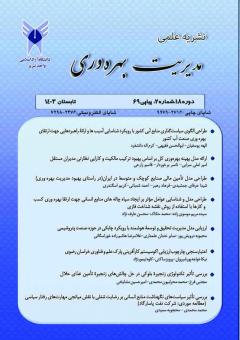طراحی مدل عوامل موثر بر ایجاد سیاه چاله های منابع انسانی با نقشه شناخت فازی
محورهای موضوعی : مدیریت(منابع انسانی)سیده مریم موسوی زاده 1 , محمد حکاک 2 , محسن عارف نژاد 3
1 - گروه مدیریت بازرگانی، دانشکده مدیریت، دانشگاه لرستان، خرم آباد، ایران
2 - گروه مدیریت بازرگانی دانشگاه لرستان- معاون آموزشی و پژوهشی دانشکده مدیریت و اقتصاد
3 - استادیار گروه مدیریت دانشگاه لرستان، ایران
کلید واژه: سیاه چاله های منابع انسانی, عملکرد منابع انسانی, نقشه شناخت فازی, نقشه استراتژی,
چکیده مقاله :
امروزه با توجه به رشد جمعیت و همچنین گسترش علم و فناوریهای جدید، کسب و کارهای گوناگونی در جامعه ایجاد شده است. که این کسبوکارها برای اینکه از بهرهوری خوبی برخوردار باشند و در مقابل رقبای خود دچار ضعف نشوند، باید به بحث منابع انسانی توجه خاصی داشته باشند. هدف این پژوهش طراحی مدلی به منظور مشخص شدن عوامل موثر بر ایجاد سیاهچالههای منابع انسانی با استفاده از نقشه شناخت فازی می باشد. جامعه آماری این تحقیق شامل خبرگان آشنا با موضوع در دانشگاه لرستان و دانشگاه آزاد می باشند که اعضای نمونه بااستفاده از روش نمونهگیری گلولهبرفی و براساس اصل اشباع نظری انتخاب شدهاند. ابزار گردآوری دادهها در بخش کیفی مصاحبه و در بخش کمی پرسشنامه است که روایی و پایایی ابزارها به ترتیب بااستفاده از روایی محتوایی و پایایی درون-کدگذار میانکدگذار برای مصاحبه و روایی محتوایی و پایایی بازآزمون برای پرسشنامه مورد تحلیل قرار گرفته است. در این پژوهش برای تحلیل داده ها در بخش کیفی از روش تحلیل محتوا و کدگذاری و در بخش کمی از روش نقشه نگاشت فازی FCM بهره گرفته شده است. نتایج پژوهش نشان داد که ترجیح تعهد بر تخصص مهمترین عامل موثر بر ایجاد سیاه چالههای منابع انسانی میباشد. پس از آن بهترتیب بی توجهی مافوق به مسائل و اتفاقات سازمان، فقدان نظام ارزیابی عملکرد درست، فردگرایی و ناکارآمدی مدیر از دیگر عوامل مهم در ایجاد سیاهچالههای منابع انسانی میباشند.
Nowadays, due to the growth of the population as well as the expansion of science and new technologies, various businesses have been created in society. that these businesses should pay special attention to the issue of human resources in order to have good productivity and not be weak in front of their competitors. The purpose of this research is to design a model in order to determine the factors affecting the creation of human resource black holes using a fuzzy cognitive map. The statistical population of this research includes experts familiar with the subject at Lorestan University and Azad University, whose sample members were selected using the snowball sampling method based on the principle of theoretical saturation. The data collection tool is an interview in the qualitative part and a questionnaire in the quantitative part, and the validity and reliability of the tools have been analyzed using content validity and intra-coder-inter-coder reliability for the interview and content validity and retest reliability for the questionnaire, respectively. In this research, the content analysis and coding methods were used in the qualitative part and the fuzzy cognitive method was used in the quantitative part to analyze the data. The results of the research showed that preference for commitment over expertise is the most important factor affecting the creation of human resource black holes. After that, the Lack of transparency in the distribution of company benefits and lack of an adequate performance evaluation system, are other important factors in creating human resource black holes.


